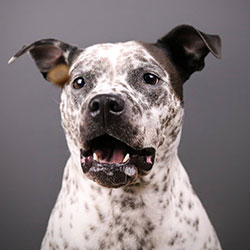How Do You Get the Perfect Pet Pic? We Asked the Pros
by Jennifer Galluzzo
There are thousands of really good pet photographers out there. But there are only a select few that take pet photography and elevate it into a true art form. The Pet Gazette sought out some of the best pet photographers and videographers in the world and interviewed them about what it takes to reach genius level when capturing our four legged, finned, and feathered friends. The results are stunning.
So, What Does It Take To Be a Great Pet Photographer?
Sure, we have a ton of photos on our phones of our pets and some are pretty good. But let’s face it – we could stand to delete a few. The true art of pet photography captures the soul of the animal. You need a keen eye and imagination. Some photographers and videographers prefer to find the spirit of the animal in their eyes, while others choose to show it through their actions. Whatever their style, the outcomes are amazing.
Of course, a lot of making the best image depends on the dog or animal, according to Will Haynes. “Some dogs are pretty calm and will just sit around while others constantly move. Some are curious while others are nervous,” he says. “Ultimately, my approach is to help tell a story of that pet. It’s nice to get a good portrait, but we want to see the animal in its’ world. This might be playing in the park, sleeping on the love seat, or being cuddled by its owner.”
Additionally, Haynes offers this advice on photographing pets:
- Be patient. It can sometimes take an animal a while to get used to you being around. Whether the animal is nervous around strangers or just wants to play with someone new, give him/her some time to get over the fact that you’re there. I often will just sit on the floor/ground and let a dog (for example) get used to me for a while.
- Select the right environment. I like areas that have good, natural light. This makes it easier for your camera to get a good picture (even on a cell phone). If you’re shooting outside, go for when the sun is low in the sky (early or late) as opposed to mid-day when the high sun will create shadows. If you’re inside, big open windows are great. I’m not a big fan of a basic flash, but will use studio lights for portraits, which works best if the animal can sit still.
- Focus on the pet’s eyes. This is the area we definitely want in focus. This might require getting the pet’s attention. A squeaky toy, treat, or even the owner’s voice can sometimes draw attention to the camera. I don’t always go for a straight on posed look, but even making a noise while a pet is moving around can draw its face up for a great picture.
- Get to the pet’s level. It’s not uncommon to see me laying on the ground or climbing under furniture. We want to see the pet in his/her world, which means getting level. Far too often, we shoot from above the pet, looking down, which can be useful, but isn’t always flattering.
- Anticipate. Pets often run around playing or exploring. You can sometimes anticipate where it’s going and be prepared to snap that shot.
Beth Gordon, a pet photographer with 24.8k followers on Instagram, takes a lot of pictures of her whippet, Kuiper, for his science & history themed account. She now has a “real” camera, but some of her favorites were taken on her phone, including one at the International Women’s Air and Space Museum and another at the Lincoln Memorial. You can see Beth’s photos at http://www.tpg.pet/beth
Regardless of the type of camera, “If you’re trying to photograph your own pet, the single most important thing you can do is train for eye contact,” Gordon advises. “I carry treats just about everywhere I go with my dog, and constantly reward him for offering eye contact and attention.”
Does Professional Equipment Make a Difference?
We know you want a different answer, but yes, it kind of does. That’s not to say you can’t capture beautiful images on your smart phone. How? In terms of getting a great picture with a phone, the basics of photography still apply. You have to pay attention to exposure (get good light, which most phones will do a decent job of figuring out on its own), composition (how the frame is setup), and focus. But the benefits of professional equipment are visible in the end product.
So, whether you’re shooting with a fancy camera or snapping shots on your smart phone, have patience, work with the pet, try to get eye contact, be flexible, and most importantly, have fun!





























